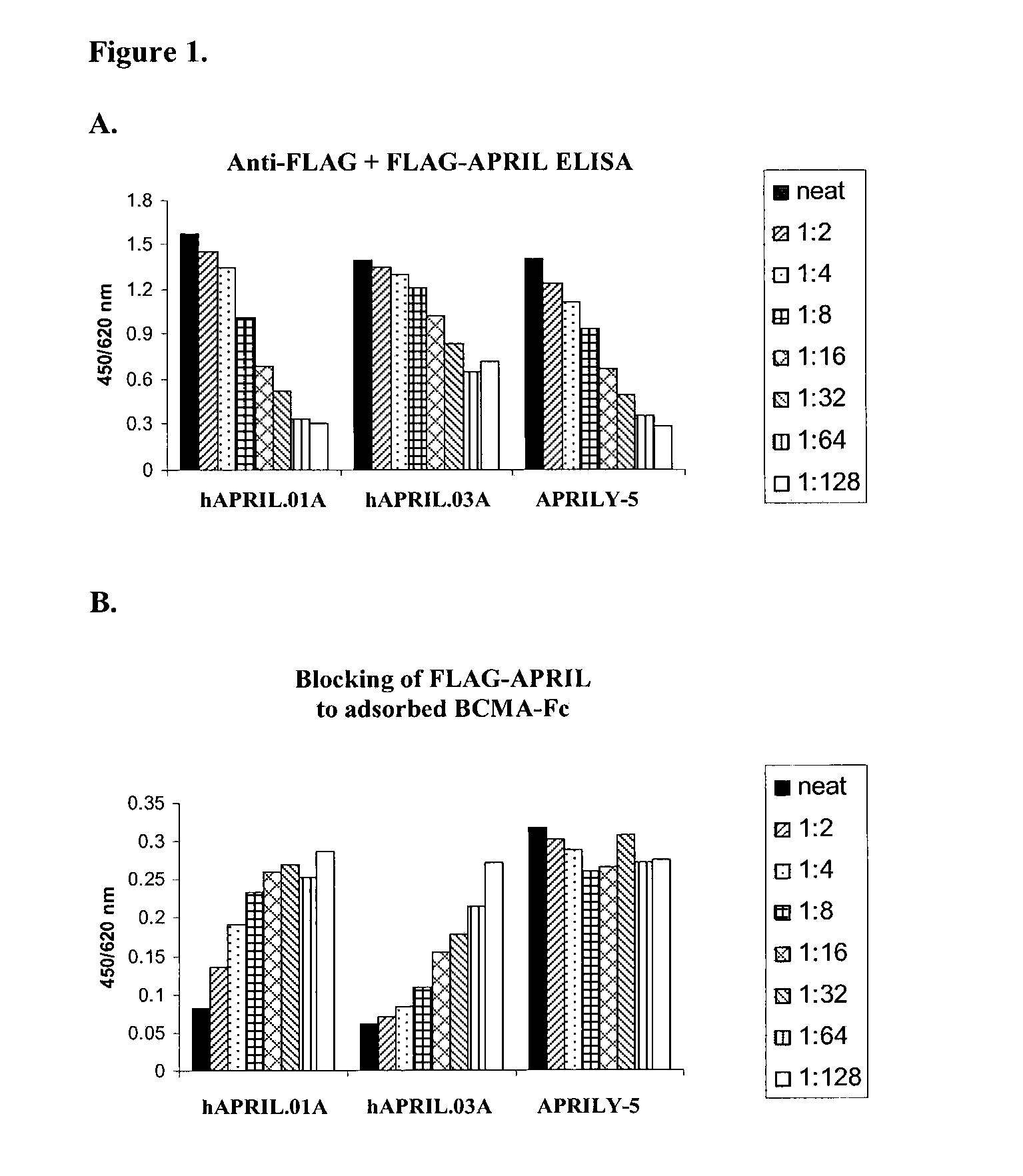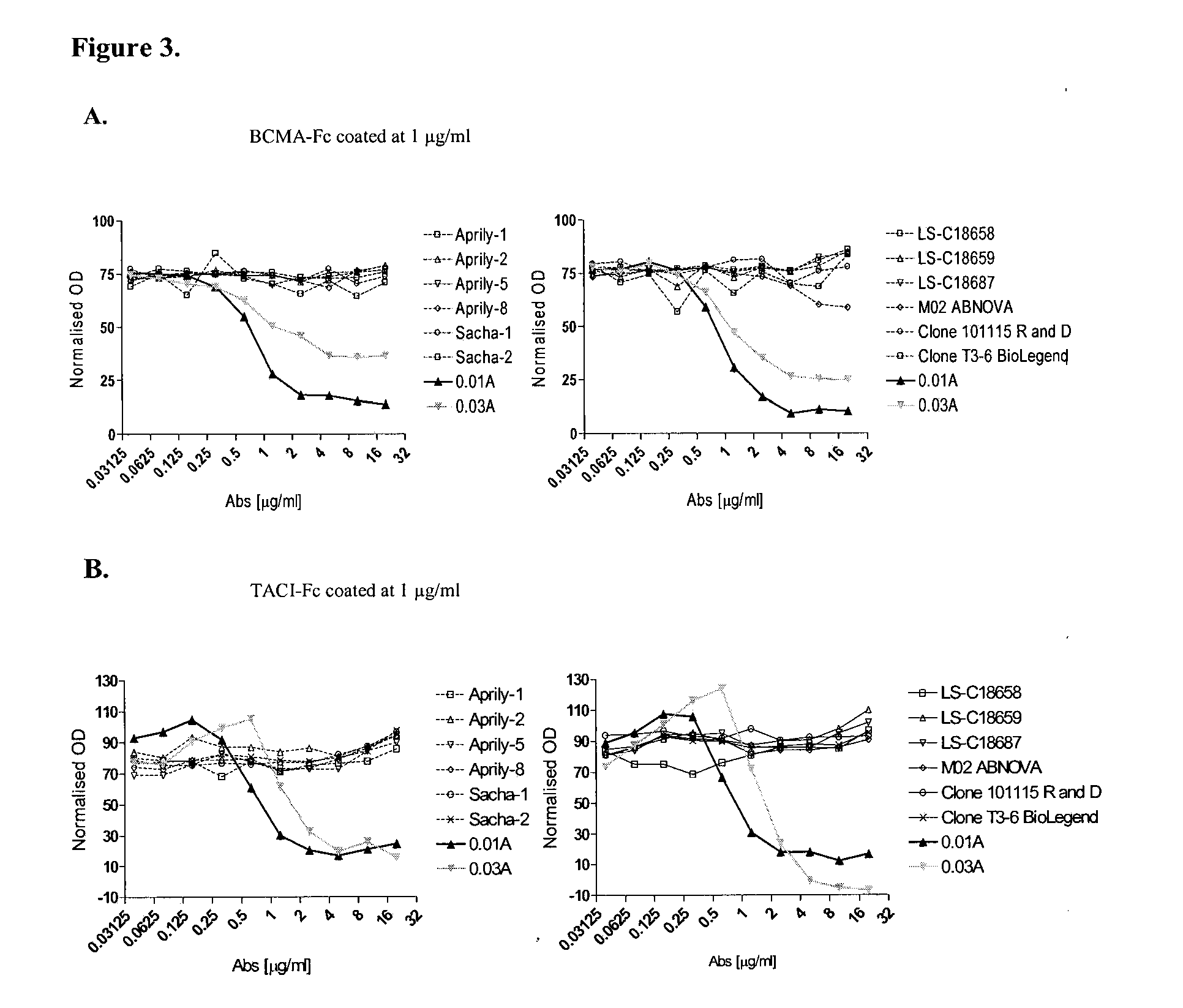Antibodies against a proliferating inducing ligand (APRIL)
a proliferating inducing ligand and antibody technology, applied in the field of april antibodies, can solve the problems of reducing the production of ifn-gamma, reducing the production of ig, and reducing the appearance of germinal centers in synovial tissue, so as to long-term immune control of disease, and induce or facilitate initial clinical response.
- Summary
- Abstract
- Description
- Claims
- Application Information
AI Technical Summary
Benefits of technology
Problems solved by technology
Method used
Image
Examples
example 1
Immunization and Selection of Anti APRIL Antibodies
[0147]Immunization of Mice with APRIL cDNA
[0148]To generate antibodies against the human APRIL protein, a cDNA encoding the full length open reading frame of APRIL was subcloned into the pCI-neo vector (Promega, Madison, Wis.). Expression of the obtained vector was checked by transient transfection of pCI-neo-hAPRIL in 293 cells (American Type Culture Collection, Manassas, Va.) and immunoblotting with mouse anti-hAPRIL IgG1 Aprily-5 (1:5,000) (Alexis, San Diego, Calif.), followed by goat anti-mouse IgG1-HRP (1:2,000) (Southern Biotechnology, Birmingham, Ala.). Mice were immunized by gene gun immunization using a Helios Gene gun (BioRad, Hercules, Calif.) and DNA coated gold bullets (BioRad) following manufacturer's instructions. Briefly, 1 μm gold particles were coated with pCI-neo-hAPRIL cDNA and commercial expression vectors for mouse Flt3L and mouse GM-CSF in a 2:1:1 ratio (both from Aldevron, Fargo, N.Dak.). A total of 1 μg of p...
example 2
Purification and Characterization of Anti-APRIL Antibodies
Stabilization of Anti-APRIL Producing Hybridomas and Purification of Anti-APRIL Antibodies
[0153]Clonal cell populations were obtained for each hybridoma by multiple rounds of limiting dilutions (six for hAPRIL.01A and four for hAPRIL.03A). Stable hybridomas were cultured in serum-free media using CELLine bioreactors (Integra-Biosciences, Chur, Switzerland) according to manufacturer's instructions. Following 7-10 days in culture, supernatants were harvested and filtered through a 0.22 μM nitrocellulose membrane. Supernatants were diluted 1:1 in high salt binding buffer (1 M Glycine / 2 M NaCl, pH 9.0), and antibodies were purified with Protein G HiTrap 5 ml columns (GE Healthcare, Piscataway, N.J.). After PBS wash of the column, antibodies were eluted with 0.1 M Glycine pH 2.7 and neutralized with 3 M Tris. Buffer was exchanged for PBS using PD-10 gel-filtration columns (GE Healthcare). Antibodies were concentrated with Amicon U...
example 3
Functional Profiling of Murine Anti-Human APRIL Antibodies
Mouse B Cell Response to APRIL
[0161]In order to show that the antibodies of this invention can functionally block APRIL in-vitro a mouse B cell assays was used to examine two APRIL driven responses in B cells—proliferation and IgA production.
[0162]All cell lines were maintained at 37° C. with 5% CO2. Mouse splenocytes and purified B cells were grown in RPMI-1640 (Gibco) supplemented with 8% FCS, 2 mM Glutamine and Beta-mercaptoethanol at 50 μM, and supplemented with penicillin and streptomycin at a concentration of 10 μg / ml. Splenic mouse B cells were isolated from wild-type mice using magnetic activated cell separation (MACS) columns with CD45R / B220 MACS beads (Miltenyi Biotec, Utrecht, The Netherlands). The cells were cultured in 96-well round-bottomed microtiter plates at a density of 2×105 / well in a final volume of 200 μl. For all assays conditioned medium containing the various forms of soluble APRIL were normalised for ...
PUM
| Property | Measurement | Unit |
|---|---|---|
| pH | aaaaa | aaaaa |
| volume | aaaaa | aaaaa |
| pH | aaaaa | aaaaa |
Abstract
Description
Claims
Application Information
 Login to View More
Login to View More - R&D
- Intellectual Property
- Life Sciences
- Materials
- Tech Scout
- Unparalleled Data Quality
- Higher Quality Content
- 60% Fewer Hallucinations
Browse by: Latest US Patents, China's latest patents, Technical Efficacy Thesaurus, Application Domain, Technology Topic, Popular Technical Reports.
© 2025 PatSnap. All rights reserved.Legal|Privacy policy|Modern Slavery Act Transparency Statement|Sitemap|About US| Contact US: help@patsnap.com



